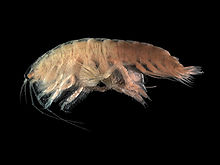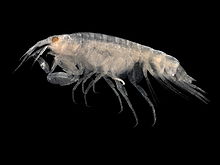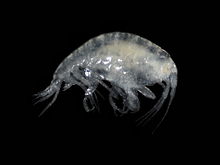Gammaridea
| Gammaridea | ||||||||||||
|---|---|---|---|---|---|---|---|---|---|---|---|---|
© Hans Hillewaert, CC BY-SA 4.0 Atylus falcatus (Dexaminidae) aus der Nordsee | ||||||||||||
| Systematik | ||||||||||||
| ||||||||||||
| Wissenschaftlicher Name | ||||||||||||
| Gammaridea | ||||||||||||
| Latreille, 1802 |
Die Gammaridea sind eine Unterordnung der Flohkrebse. Sie stellen mit ca. 4000 Arten die zweitgrößte Gruppe der rund 9500 bekannten Flohkrebsarten dar.[1] Die meisten Süßwasserarten, darunter der heimische Bachflohkrebs aus der Familie der Gammaridae und der in Nordamerika weit verbreitete Mexikanische Flohkrebs aus der Familie der Hyalellidae, gehören jedoch nicht mehr zu dieser Gruppe. Diese wurden zusammen mit einigen anderen Familien der Gammaridea und allen Arten, die früher den Unterordnungen Corophiidea und Caprellidea zugeordnet worden waren, in der im Jahre 2013 neu errichteten Unterordnung Senticaudata vereinigt.[2]
Verbreitung
Die Gammaridea sind weltweit verbreitet. Die meisten Familien leben im Meer, von der Arktis und der Antarktis bis in äquatoriale Breiten. Größtenteils sind sie Bodenbewohner, einige sind jedoch auch im Zooplankton zu finden. Sie kommen an den Küsten bis hinauf ins Supralitoral der Strände vor, viele neue Arten wurden jedoch auch in der Tiefsee entdeckt. Manche Arten wie der Höhlenflohkrebs besiedeln auch Höhlen- und Grundwasserbiotope.
Ernährung
Die Gammaridea ernähren sich größtenteils von Detritus, d. h. von pflanzlichen und tierischen Resten, die zu Boden sinken. Es gibt aber auch räuberische Formen im Zooplankton, die sich von Salpen und Copepoden ernähren. Andere besitzen saugende Mundwerkzeuge, mit denen sie halbparasitisch oder als Kommensalen mit Salpen leben. Dazu gehören die Familien Stenothoidae, Leucothoidae und Dexaminidae.
Lebensweise
Die Arten der Familie Ampeliscidae bauen röhrenförmige Höhlen mit Hilfe von sekretorischen Drüsen, mit denen die das feste Baumaterial verkleben. Die Drüsen befinden sich auf den ersten beiden Paaren ihrer Pereiopoden oder als kutikuläre Drüsen auf der Körperoberfläche. Sie nutzen ihre speziell entwickelten Antennen zum Filtrieren.
Die Arten der Phoxocephalidae und Haustoriidae nutzen ihre Gliedmaßen zum Graben im Sediment. Einige verdauen dabei den detritusreichen Schlamm und verwerten das darin befindliche organische Material.
Familien
Die Systematik der Gammaridea ist oft Revisionen unterworfen. Speziell die Gruppierung und Zusammenfassung der Familien in Überfamilien variiert.[3]
Stand: 1. April 2014
- Nicht in Überfamilien zusammengefasste Familien:
- Acanthonotozomatidae Stebbing, 1906
- Acanthonotozomellidae Coleman & Barnard, 1991
- Alicellidae Lowry & De Broyer, 2008
- Amathillopsidae Pirlot, 1934
- Ampeliscidae Krøyer, 1842
- Amphilochidae Boeck, 1871
- Argissidae Walker, 1904
- Astyridae Pirlot, 1934
- Atylidae Lilljeborg, 1865
- Bateidae Stebbing, 1906
- Bolttsiidae Barnard & Karaman, 1987
- Cheidae Thurston, 1982
- Cheluridae Allman, 1847
- Colomastigidae Stebbing, 1899
- Condukiidae Barnard & Drummond, 1982
- Cressidae Stebbing, 1899
- Cyproideidae J.L. Barnard, 1974
- Dexaminidae Leach, 1814
- Didymocheliidae Bellan-Santini & Ledoyer, 1987
- Dikwidae Coleman & Barnard, 1991
- Epimeriidae Boeck, 1871
- Exoedicerotidae Barnard & Drummond, 1982
- Haustoriidae Stebbing, 1906
- Hyperiopsidae Bovallius, 1886
- Ipanemidae Barnard & Thomas, 1988
- Iphimediidae Boeck, 1871
- Lafystiidae Sars, 1893
- Laphystiopsidae Stebbing, 1899
- Lepechinellidae Schellenberg, 1926
- Leucothoidae Dana, 1852
- Maxillipiidae Ledoyer, 1973
- Megaluropidae Thomas & Barnard, 1986
- Melphidippidae Stebbing, 1899
- Miramarassidae Lowry, 2006
- Nihotungidae J.L. Barnard, 1972
- Ochlesidae Stebbing, 1910
- Oedicerotidae Lilljeborg, 1865
- Pagetinidae K.H. Barnard, 1931
- Paracalliopiidae Barnard & Karaman, 1982
- Pardaliscidae Boeck, 1871
- Phoxocephalidae Sars, 1891
- Phoxocephalopsidae Barnard & Drummond, 1982
- Platyischnopidae Barnard & Drummond, 1979
- Pleustidae Buchholz, 1874
- Podosiridae Lowry & Myers, 2012
- Pseudamphilochidae Schellenberg, 1931
- Sebidae Walker, 1908
- Sicafodiidae Just, 2004
- Stegocephalidae Dana, 1855
- Stenothoidae Boeck, 1871
- Stilipedidae Holmes, 1908
- Synopiidae Dana, 1853
- Thurstonellidae Lowry & Zeidler, 2008
- Urohaustoriidae Barnard & Drummond, 1982
- Urothoidae Bousfield, 1978
- Valettiidae Stebbing, 1888
- Valettiopsidae Lowry & De Broyer, 2008
- Vicmusiidae Just, 1990
- Vitjazianidae Birstein & M. Vinogradov, 1955
- Zobrachoidae Barnard & Drummond, 1982
Für einige Familien wurden bereits Überfamilien errichtet:
- Überfamilie Eusiroidea Bousfield, 1979
- Eusiridae Stebbing, 1888
- Überfamilie Liljeborgioidea Stebbing, 1899
- Liljeborgiidae Stebbing, 1899
- Überfamilie Lysianassoidea Dana, 1849
- Acidostomatidae Stoddart & Lowry, 2012
- Amaryllididae Lowry & Stoddart, 2002
- Aristiidae Lowry & Stoddart, 1997
- Cebocaridae Lowry & Stoddart, 2011
- Cyclocaridae Lowry & Stoddart, 2011
- Cyphocarididae Lowry & Stoddart, 1997
- Endevouridae Lowry & Stoddart, 1997
- Eurytheneidae Stoddart & Lowry, 2004
- Hirondelleidae Lowry & Stoddart, 2010
- Izinkalidae Lowry & Stoddart, 2010
- Kergueleniidae Lowry & Stoddart, 2010
- Lepidepecreellidae Stoddart & Lowry, 2010
- Lysianassidae Dana, 1849
- Opisidae Lowry & Stoddart, 1995
- Pachynidae Lowry & Stoddart, 2012
- Podoprionidae Lowry & Stoddart, 1996
- Scopelocheiridae Lowry & Stoddart, 1997
- Sophrosynidae Lowry & Stoddart, 2010
- Thoriellidae Lowry & Stoddart, 2011
- Trischizostomatidae Lilljeborg, 1865
- Uristidae Hurley, 1963
- Wandinidae Lowry & Stoddart, 1990
- Lysianassoidea incertae sedis
- Überfamilie Pontoporeioidea Dana, 1853
- Pontoporeiidae Dana, 1853
- Priscillinidae d'Udekem d'Acoz, 2006
Einzelnachweise
- ↑ T. Horton, J. Lowry, J. & C. De Broyer (Hrsg.): Introduction, World Amphipoda Database, 2013, abgerufen am 2. April 2014
- ↑ James K. Lowry & Alan A. Myers: A Phylogeny and Classification of the Senticaudata subord. nov. (Crustacea: Amphipoda). Zootaxa, 3610, 1, S. 1–80, 2013
- ↑ C. De Broyer: Gammaridea. In: T. Horton, J. Lowry & C. De Broyer: World Amphipoda Database. Accessed through: World Register of Marine Species (WoRMS), 2013, abgerufen am 3. April 2014
Literatur
- Ignacio L. Chiesa und Gloria M. Alonso: Biodiversity of the Gammaridea and Corophiidea (Crustacea: Amphipoda) from the Beagle Channel and the Straits of Magellan: a preliminary comparison between their faunas. Online-Fassung (PDF; 288 kB)
- J. Laurens Barnard: Gammaridean Amphipoda from a Deep-Sea Transect off Oregon. Smithsonian Contributions to Zoology, Nr. 61, 1971 Online-Fassung (PDF; 3,4 MB)
- E. L. Bousfield: A new look at the systematics of Gammaridean amphipods of the world. Crustaceana, Suppl. 4, S. 282–316, 1977
- Jean-Claude Dauvin und Denise Bellan-Santini: Biodiversity and the biogeographic relationships of the Amphipoda: Gammaridea on the French coastline. Journal of the Marine Biological Association of the United Kingdom, Vol. 84, Nr. 3, S. 621–628, Cambridge University Press, Cambridge, 2004
- Jerry Laurens Barnard: The Families and Genera of Marine Gammaridean Amphipoda. U.S. National Museum Bulletin, Nr. 271, 1969. Reprint in: Crustaceana, Volume 43, Nr. 2, 1982
Weblinks
- C. De Broyer: Gammaridea. In: T. Horton, J. Lowry & C. De Broyer: World Amphipoda Database. Accessed through: World Register of Marine Species (WoRMS), 2013, abgerufen am 3. April 2014
- Die Unterordnung „Gammaridea“ der Flohkrebse. In: Fauna Europaea Database. European Commission under the Fifth Framework Programme, abgerufen am 27. Februar 2010 (englisch).
Auf dieser Seite verwendete Medien
© Hans Hillewaert, CC BY-SA 4.0
A fossorial amphipod from the Belgian Continental Shelf.
Camera mounted on a Zeiss Stemi C-2000 binocular microscope
Length: ~8 mm.
Autor/Urheber: Daiju Azuma, Lizenz: CC BY-SA 2.5
ja:カイコウオオソコエビ A kind of Amphipod. Lived in 10900m depth in the Mariana Trench.
- Species
- Hirondellea gigas
- Familia
- Uristidae
- Source http://opencage.info/pics/large_7406.asp
- Location Shin-Enoshima Aquarium, Japan
- Copyright OpenCage
© Hans Hillewaert, CC BY-SA 4.0
Amphipod with a short, pointed down-turned rostrum. Sampled on mid-sized sediments on the Belgian Continental Shelf in 1999.
Geo-location not applicable as the picture was later taken in the lab.
Picture taken with a camera mounted on a Zeiss Stemi C-2000 binocular microscope
Length: ~5 mm
© Hans Hillewaert, CC BY-SA 4.0
Burying amphipod from intertidal sandy substrates.
Camera mounted on a Zeiss Stemi C-2000 binocular microscope
Length: ~6 mm.
Belgian Coast.
© Hans Hillewaert, CC BY-SA 4.0
Benthic amphipod, taken with Leica DFC 490 camera mounted on a Leica M205C binocular microscope. Pereiopod 3 is extremely large with a long and robust merus, a short carpus and a strong and slightly curved propodus with an enormous falciform dactylus. The 12 segmented flagellum is one of the features distinguishing this species from the similar Atylus swammerdami. Collected in 2010 on the S2 dredge disposal site off Zeebrugge in the Belgian part of the North Sea 2010.
Length = ~4.5 mm
Focus stacking aus 35 Bildern.
© Hans Hillewaert, CC BY-SA 4.0
Amphipod taken with an Axiocam (Zeiss) camera mounted on a Zeiss Stemi C-2000 binocular microscope. The amphipod was sampled on the Belgian Continental Shelf in 1997.
Length: ~3 mm.
© Hans Hillewaert, CC BY-SA 4.0
Amphipod with two antennae of near equal length and large gnathopods. Sampled on fine-grained sediments on the Belgian Continental Shelf.
Geo-location not applicable as the picture was taken in the lab.
Picture taken with a camera mounted on a Zeiss Stemi C-2000 binocular microscope
Length: ~4 mm
© Hans Hillewaert, CC BY-SA 4.0
Burying amphipod from subtidal sandy substrates.
Camera mounted on a Zeiss Stemi C-2000 binocular microscope
Length: ~4 mm.
Dutch Continental Shelf. Geo-location gives the position where the amphipod was sampled in 2004.
© Hans Hillewaert, CC BY-SA 4.0
Benthic amphipod, taken with Axiocam (Zeiss) camera mounted on a Zeiss Stemi C-2000 binocular microscope.
Belgian Continental Shelf 2004.
© Hans Hillewaert, CC BY-SA 4.0
Commensal amphipod, taken with Axiocam (Zeiss) camera mounted on a Zeiss Stemi C-2000 binocular microscope. This amphipod was sampled on the Belgian Continental Shelf in 1997.



















